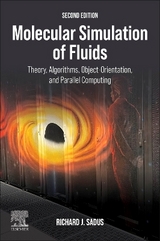
Molecular Simulation of Fluids
Elsevier Science Ltd (Verlag)
978-0-444-51082-2 (ISBN)
- Titel erscheint in neuer Auflage
- Artikel merken
The concepts of object-orientation are consistently applied to molecular simulation and a complete object-oriented analysis is given of both Monte Carlo and molecular dynamics simulations. Sample simulation C++ code is provided on the accompanying disk. This monograph describes the application of object-orientation to molecular simulation.
Richard J. Sadus is a professor at Swinburne University of Technology, where he has held leadership positions as acting dean, department chair and centre director. His research has also been conducted at the universities of Karlsruhe and Cologne under the auspices of the Alexander von Humboldt Foundation and he was previously a visiting researcher at the University of California, Berkeley. A focus of current research is the development of molecular simulation methods to directly predict thermodynamic properties and phase behaviour from the underlying inter-particle interactions. This involves using object-oriented techniques and parallel programming on high performance computing environments. Professor Sadus is the author of an earlier research monograph: “High Pressure Phase Behaviour of Multicomponent Fluid Mixtures, which is also published by Elsevier. He is a Fellow of the American Institute of Chemical Engineers.
Preface. List of Algorithms. Notation. 1. Introduction. What is molecular simulation? Progress in molecular simulation. 2. Theoretical Foundations. Basic statistical mechanics. Particle dynamics. Summary. 3. Intermolecular Potentials. Calculation of the potential energy. Intermolecular forces. Pairwise potentials for atoms and simple molecules. Contributions to molecular interactions. Simple pairwise potentials for molecules. Pairwise potentials from molecular mechanics. Many-body interactions for atoms. Many-body interactions for molecules. Ab initio calculations. Summary. 4. Calculating Molecular Interactions. Calculation of short-range interactions. Calculation of long-range interactions. Summary. 5. Monte Carlo Simulation. Basic concepts. Application to molecules. Some recent developments. Summary. 6. Integrators for Molecular Dynamics. Integrating the equations of motion. Gear predictor-corrector methods. Verlet predictor methods. Comparison of integrators. Integrators for molecules. Summary. 7. Non-Equilibrium Molecular Dynamics. Synthetic NEMD algorithms. Application of NEMD algorithms to molecules. Application of NEMD algorithms to mixtures. Comparison with equilibrium molecular dynamics. Summary. 8. Molecular Simulation of Ensembles. Monte Carlo methods. Molecular dynamics. Summary. 9. Molecular Simulation of Phase Equilibria. Calculating the chemical potential. Monte Carlo grand canonical Gibbs ensemble. Molecular dynamics grand canonical Gibbs ensemble. NPT + test particle. Gibbs-Duhem integration. Thermodynamic scaling. Pseudo ensemble methods. Histogram re-weighting algorithms. Finite size scaling. Summary. 10. Molecular Simulation and Object-Orientation. Fundamental concepts of object-orientation. Application of object-orientation to microcanonical molecular dynamics simulation of Lennard-Jones atoms. Application of object-orientation to a microcanonical Monte Carlo simulation of Lennard-Jones atoms. Combined molecular dynamics and Monte Carlo program for Lennard-Jones atoms in the microcanonical ensemble. Extensions. Summary. Appendices: A. Software User's Guide. B. Simulation Resources. Index.
| Erscheint lt. Verlag | 17.5.2002 |
|---|---|
| Verlagsort | Oxford |
| Sprache | englisch |
| Maße | 152 x 229 mm |
| Gewicht | 1020 g |
| Themenwelt | Informatik ► Grafik / Design ► Digitale Bildverarbeitung |
| Informatik ► Software Entwicklung ► Objektorientierung | |
| Naturwissenschaften ► Chemie ► Physikalische Chemie | |
| Naturwissenschaften ► Physik / Astronomie ► Festkörperphysik | |
| Technik ► Bauwesen | |
| Technik ► Umwelttechnik / Biotechnologie | |
| ISBN-10 | 0-444-51082-6 / 0444510826 |
| ISBN-13 | 978-0-444-51082-2 / 9780444510822 |
| Zustand | Neuware |
| Haben Sie eine Frage zum Produkt? |
aus dem Bereich



